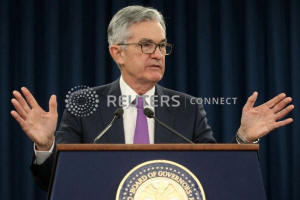|
A Fed pivot, born of volatility,
missteps, and new economic reality
 Send a link to a friend
Send a link to a friend
 [February 22, 2019]
By Howard Schneider and Jonathan Spicer [February 22, 2019]
By Howard Schneider and Jonathan Spicer
WASHINGTON (Reuters) - The Federal
Reserve's promise in January to be "patient" about further interest rate
hikes, putting a three-year-old process of policy tightening on hold,
calmed markets after weeks of turmoil that wiped out trillions of
dollars of household wealth.
But interviews with more than half a dozen policymakers and others close
to the process suggest it also marked a more fundamental shift that
could define Chairman Jerome Powell's tenure as the point where the Fed
first fully embraced a world of stubbornly weak inflation, perennially
slower growth and permanently lower interest rates.
Along with Powell's public comments, Fed minutes, and other documents,
the picture emerges of a central bank edging towards a period of
potentially difficult change as it reviews how to do business in light
of that new reality. One question, for example, is whether to make
crisis-fighting policies a part of the routine toolkit. Another is
whether to try to prepare the public to accept higher inflation from
time to time.
Policymakers have debated for years how well traditional central banking
fits a world transformed by the global financial crisis a decade ago.
But it was a brief Oct. 3 remark by Powell that set off the chain of
events which helped settle the matter.

"We're a long way from neutral now, probably," Powell said at a
Washington think-tank event, referring to a level of interest rates that
neither cool or boost the economy.
Though Powell was effectively summarizing what the Fed had just
concluded at its Sept. 25-26 policy meeting, when it raised rates amid
stronger than expected U.S. growth, his characterization touched a
nerve.
Investors dumped stocks and bonds, fearing the Fed aimed to drive rates
higher than they felt the economy could withstand.
It was the beginning of weeks of volatility that led the Fed to
recalibrate its message, with more than one misstep along the way.
In doing so, the central bank went beyond fine-tuning its language or
adjusting to changing conditions. Interviews with officials as well as
analysis of Fed minutes and policymakers' public statements suggest the
emergence of a long-elusive consensus that interest rates would likely
never return to pre-crisis levels, and that once established
relationships, such as inflation rising when unemployment fell, no
longer worked.
Concern that years of solid economic growth and falling unemployment
would inevitably rekindle inflation or threaten financial stability have
been a staple of Fed debates, but had largely disappeared by the Fed's
Dec. 18-19 meeting, according to a review of Fed meeting minutes and
officials' public statements.
GRAPHIC - How the Fed's meeting minutes reflected changing views on
interest rates: https://tmsnrt.rs/2TX9fC0
It was a conclusion hiding in plain sight. After a year when the Trump
administration pumped around $1.5 trillion of tax cuts and public
spending into a full employment economy, the Fed in 2018 would miss its
2 percent inflation target yet again.
"I hate to say we were right," Dallas Federal Reserve president Robert
Kaplan told reporters on Jan. 15 in Dallas. "But we have been warning
for quite some time that...the structure of the economy has changed
dramatically."
Technological innovation, globalization, and the Fed's commitment to its
inflation target all held down prices, and "those forces are powerful
and they are accelerating," he said.
His arguments echoed those made by St. Louis Fed president James Bullard
and Minneapolis Fed president Neel Kashkari. New Fed vice chairman
Richard Clarida and Governor Lael Brainard have flagged similar issues.

Later in January, the Fed's policy meeting jettisoned mention of any
further rate increases and cited "muted inflation" among the reasons,
largely aligning the Fed with the prevailing sentiment among investors
who saw conditions weakening.
At first, it was investors who appeared to have overreacted to Powell's
"long way from neutral" remark in early October.
Global markets had absorbed nearly two years of quarterly Fed rate
increases in stride, but yields on U.S. 10 year Treasury bonds spiked a
tenth of a percentage point that day and stocks started a slide that
wiped out 10 percent of the S&P 500's value by late November.
If sustained, It was the type of environment, with asset values falling
and borrowing conditions tightening, that could hurt the Main Street
economy and not just the investor class.
The initial response from Powell and others at the Fed was that the U.S.
economy remained strong, and that it was not the central bank's job to
coddle Wall Street.
"We watch markets very carefully," Powell said at a mid-November event
in Dallas. "But it is one of many, many factors that go into a very
large economy.”
But investors were not just reacting to the Fed and the prospect of
higher rates. Weakening business and consumer confidence, slowing global
growth, and potential disruptions from President Donald Trump's trade
war with China also factored in.
Over the next few weeks the Fed tried to build those concerns into its
policy stance, but it became clear the situation was more fragile than
they had divined.
[to top of second column]
|

Federal Reserve Chairman Jerome Powell holds a press conference
following a two day Federal Open Market Committee policy meeting in
Washington, U.S., January 30, 2019. REUTERS/Leah Millis -/File Photo

In early December a portion of the bond yield curve "inverted," with
short term rates rising above long term ones in what can be seen as
a loss of faith in economic growth.
For months, Fed officials had debated whether to discount such
developments as the clash and clang of daily trading or to treat
them as a significant warning. Some, including Bullard, warned
against ignoring what markets seemed to be saying, and both he and
Kashkari said the Fed should stop raising rates or risk trouble.
When the Fed met in December, policymakers thought they could square
the circle.
Officials proceeded with another quarter-point rate increase, as
expected at the time, and released updated projections showing two
more rate hikes for 2019 - one less than in September, but still
heading higher.
LOST NUANCE
The Fed hoped, though, that between a small change in its policy
statement and Powell's follow-up news conference, things would stay
calm, a strategy Fed officials spelled out after the fact in
interviews and in minutes of the December meeting.
By replacing the phrase that the Fed "expected" further rate hikes
with one saying it "judged" them likely, the central bank tried to
show it was now less committed to tighter policy.
But that nuance was lost on markets, and Powell's assurance at the
news conference of a newly "patient" Fed got lost as well when he
described the Fed's monthly rundown of as much as $50 billion in
assets as on "automatic pilot."
To investors, that undermined the intended message, since the
regular decline in the Fed's asset holdings effectively worked to
tighten financial conditions.
The S&P 500 fell another 7.5 percent in the days that followed.
Investors felt the Fed was "not fully appreciating" how market
turbulence and "softening global data" put the U.S. itself at risk,
the Fed's January minutes concluded in reviewing how the December
statement was perceived.

“It was a delicate time," New York Fed President John Williams told
Reuters on Tuesday. The tweak in the December statement "was a
pretty subtle message. That’s one of the challenges of trying to
communicate a very complicated and complex situation in just one
page."
Over the next few weeks, the Fed eschewed subtlety for a more public
acknowledgement that its view of economic reality had changed.
For a Jan. 4 question-and-answer session at the American Economic
Association Powell came armed with written notes and a core message
that the Fed was "always prepared to shift the stance of policy and
to shift it significantly” if conditions weakened.
After the January meeting that message became official. References
to the new "patient" approach and "muted inflation," words cited in
minutes of the December meeting, became part of the Fed's policy
statement. A longstanding mention of the need for higher rates was
deleted.
The changes drew no dissent, with even those who have worried most
about inflation and financial risk falling silent.
It was a significant moment of unanimity at a central bank that has
spent the last decade wondering when, rather than whether, inflation
or financial risks would re-emerge. Throughout that era some group
of officials - including Powell early in his central banking career
- has consistently warned that the combination of falling
unemployment, cheap money, and trillions of dollars injected by the
Fed's crisis era policies would inevitably cause problems.
As the Fed's January meeting minutes showed, not all officials have
sworn off further rate increases and some noted that a possible turn
for the better - a resolution of trade tensions for example - could
lead them to raise rates again.
But to veteran Fed watchers, the bar is now higher. The January
statement, JP Morgan analyst Michael Feroli wrote recently, showed
the Fed "subtly but profoundly evolving" to a new view of the world
where a variety of forces have changed the way inflation and
interest rates work, and have now changed how the central bank
responds.
(Reporting by Howard Schneider; Additional reporting by Ann Saphir
and Jason Lange; Editing by Dan Burns and Tomasz Janowski)
[© 2019 Thomson Reuters. All rights
reserved.]
Copyright 2019 Reuters. All rights reserved. This material may not be published,
broadcast, rewritten or redistributed.
Thompson Reuters is solely responsible for this content.
 |